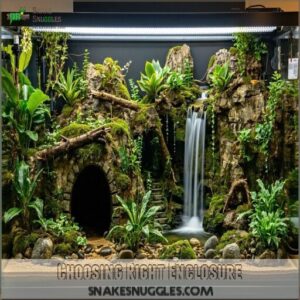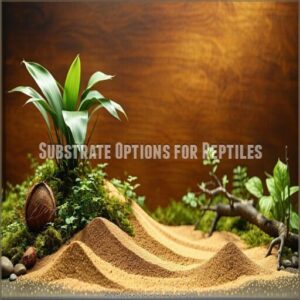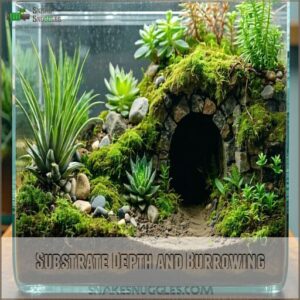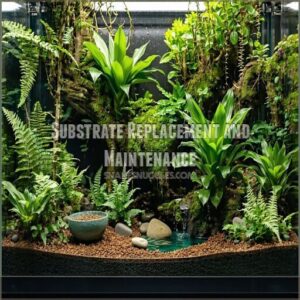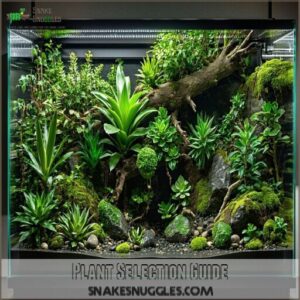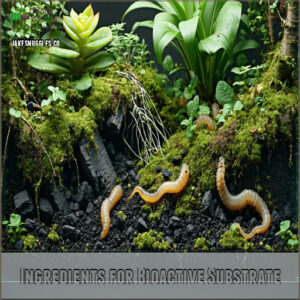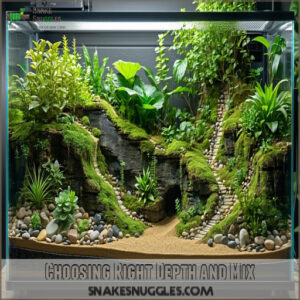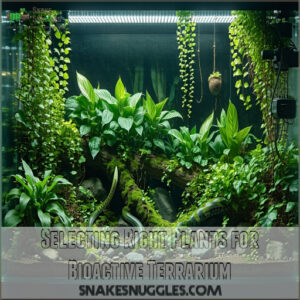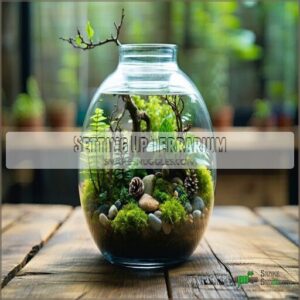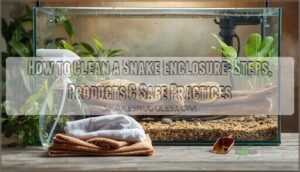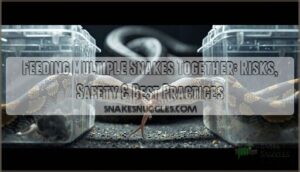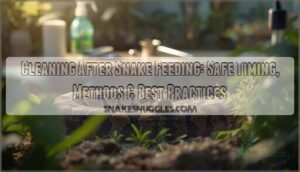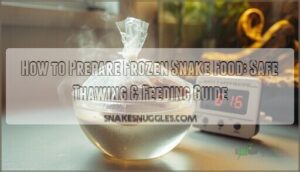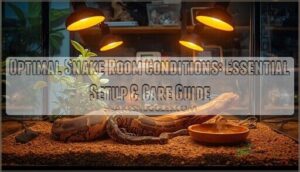This site is supported by our readers. We may earn a commission, at no cost to you, if you purchase through links.
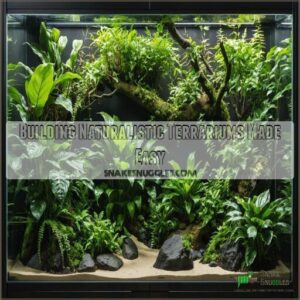 You’re about to start building naturalistic terrariums, and it’s easier than you think.
You’re about to start building naturalistic terrariums, and it’s easier than you think.
Start by choosing the right enclosure, considering your reptile’s species-specific needs. Select a substrate that suits their humidity requirements, like ReptiSand or coconut fiber.
Pick plants that thrive in low light, like pothos or ferns. As you create your mini-ecosystem, remember to balance substrate, plants, and decor for a thriving environment.
With the right mix, you’ll be on your way to crafting a stunning, self-sustaining world – and that’s just the beginning of your terrarium journey.
Table Of Contents
- Key Takeaways
- Choosing Right Enclosure
- Selecting Substrate
- Plant Selection Guide
- Creating Bioactive Environment
- Setting Up Terrarium
- Frequently Asked Questions (FAQs)
- How to set up a naturalistic terrarium?
- How do you make a natural terrarium?
- Is it cheaper to build your own terrarium?
- What are common mistakes made when building and maintaining a terrarium?
- How often to water terrarium plants?
- Can I use regular potting soil inside?
- What causes mold in terrarium environments?
- How to introduce microfauna safely?
- Are all types of moss suitable?
- Conclusion
Key Takeaways
- You’ll choose the right enclosure for your reptile by considering species-specific needs, enclosure size, and other factors to create a healthy and thriving environment.
- You’ll select a substrate that suits your reptile’s humidity requirements, such as ReptiSand or coconut fiber, and maintain it by replacing it every 4-6 weeks.
- You’ll pick reptile-safe plants like pothos, ferns, and bromeliads that thrive in low light, and arrange them to create hiding spots and contribute to humidity control.
- You’ll create a bioactive environment by combining the right ingredients, such as substrate, plants, and microfauna, and maintain it by monitoring and adjusting temperature, humidity, and lighting conditions to create a healthy environment.
Choosing Right Enclosure
You’re about to create a naturalistic terrarium, and choosing the right enclosure is essential.
You’ll need to evaluate the species’ requirements, enclosure size, and other factors to make sure a healthy and thriving environment for your reptiles.
Reptile Species Requirements
When designing reptile terrariums, research the species’ behavior, habitat, and environmental needs to guarantee animal safety and a naturalistic environment, considering reptile behavior and species research for effective reptile habitat design in your bioactive terrarium.
To create a suitable environment, understanding species specific needs is essential for the well-being of the animals, and this understanding is crucial for effective reptile habitat design.
Enclosure Size Considerations
You’ll need to evaluate space requirements, container depth, and species needs when choosing a reptile enclosure size.
Climber enclosures are taller, while burrower habitats are deeper, affecting terrarium design and naturalistic terrariums’ overall aesthetic, ensuring the right enclosure shape for your species.
Proper enclosure maintenance involves understanding optimal humidity levels to create a healthy environment for your reptiles, which is crucial for their well-being and requires careful consideration of species needs.
Factors Affecting Enclosure Choice
When choosing a reptile enclosure, several factors come into play. It’s not just about enclosure size, but also about creating an environment that meets the specific needs of your pet.
Here are some key considerations:
- Species Needs: Different reptiles have unique requirements for space, temperature, and humidity. Research your pet’s natural habitat and adapt your terrarium design accordingly.
- Lighting Requirements: The right lighting is critical for your reptile’s health and the growth of any plants in the enclosure. UVB lighting, for example, is essential for diurnal species.
- Ventilation Systems: Proper ventilation provides fresh air and helps regulate humidity. This is essential for maintaining the health of your reptile and preventing respiratory issues.
- Humidity Control: Depending on the species, you may need to adjust humidity levels. This can be done through misting, the use of water features, or by choosing specific substrates and plants.
Selecting Substrate
You’re now ready to select a substrate that meets your terrarium’s specific needs.
You’ll choose from various options, considering factors like drainage, moisture, and the type of plants and animals you’re working with.
Substrate Options for Reptiles
I’ll explore substrate options, like ReptiSand and coconut fiber, considering reptile safety and humidity control, with ingredients such as peat moss and coconut husk for a bioactive substrate.
When choosing a substrate, it’s essential to research reptile safe substrates to verify the health and well-being of your reptiles.
The following table compares different substrate options:
| Substrate | Humidity | Reptile Safety |
|---|---|---|
| ReptiSand | Low | High |
| Coconut Fiber | Low | High |
| Peat Moss | High | Medium |
| Coconut Husk | Medium | High |
This information can help you make an informed decision about the best reptile safety and humidity control for your reptiles.
Substrate Depth and Burrowing
Beyond the type of substrate, the depth you choose is key, especially for burrowers. A shallow substrate won’t cut it for these critters! Think 4-6 inches of burrowing depth for your little excavators.
Proper substrate depth impacts:
- Burrowing behavior
- Root growth for your reptile-safe plants
- Drainage importance within the bioactive substrate
This layered approach prevents soil compaction and guarantees a healthy environment. The correct selection of a suitable burrowing substrate is essential for maintaining the overall ecosystem.
Substrate Replacement and Maintenance
You’ll replace substrate every 4-6 weeks, ensuring ideal soil quality and moisture control.
A bioactive substrate requires a balanced replacement schedule to maintain humidity levels, while incorporating reptile-safe plants and substrate ingredients for effective terrarium maintenance, which includes reptile-safe plants.
Plant Selection Guide
You’re now ready to choose the perfect plants for your terrarium, and it’s important to select species that thrive in your desired environment.
You’ll learn how to pick reptile-safe plants, arrange them for ideal hiding spots, and understand their role in maintaining humidity and aesthetics in your terrarium.
Reptile-Safe Plants and Placement
Safe plant choices are important for a thriving reptile terrarium. Consider toxicity concerns when selecting plants.
Reptile-safe plants like pothos, ferns, and bromeliads offer enrichment value. Think about placement strategies to maximize their benefits.
When creating a terrarium, understanding snake tank plants is essential for a healthy environment.
- Pothos: Easy-to-care-for vine
- Ferns: Enhance humidity
- Bromeliads: Add a splash of color
- Spider plants: Another safe and attractive option
Strategic Plant Arrangement for Hiding
You arrange plants to create hiding spots, using visual barriers and varying plant density.
| The arrangement considers different | Foliage types | Species needs | Hiding spots |
|---|---|---|---|
| Ferns | Humidity | Undergrowth | |
| Vines | Climbing | Vertical | |
| Bushes | Shelter | Densely planted |
This strategy allows for the creation of complete concepts such as undergrowth, vertical, and densely planted areas, each serving a specific purpose in the arrangement.
Plant Contribution to Humidity and Aesthetics
As you design your naturalistic terrarium, consider plant choices that contribute to humidity control and aesthetic design.
Creating a microclimate with green walls and miniature landscapes, where terrarium plants thrive, maintaining ideal humidity levels within the plant terrarium ecosystem.
Creating Bioactive Environment
You’re about to create a bioactive environment, which is a key step in building a naturalistic terrarium.
By combining the right ingredients, such as substrate, plants, and microfauna, you’ll be able to replicate a thriving ecosystem that’s easy to maintain and beautiful to observe.
Ingredients for Bioactive Substrate
To craft a premium terrarium substrate mix, you’ll want to blend the right ingredients.
Here are four key components to get you started:
- Coco Coir: a nutrient-rich base for your bioactive substrate
- Peat Moss: retains moisture and supports microbe growth
- Leaf Litter: contributes to the decomposition process and nutrient cycle
- Earthworm Castings: introduces beneficial microorganisms for a healthy ecosystem
When selecting ingredients, consider the importance of a bioactive substrate mix for a thriving terrarium environment.
Choosing Right Depth and Mix
You’ll want a substrate mix with proper drainage layers, considering burrowing depth and plant root space.
To meet microfauna needs in your bioactive substrate, ensuring a healthy terrarium substrate with adequate substrate depth.
Selecting Right Plants for Bioactive Terrarium
You’re selecting plants for your bioactive terrarium, considering species like ferns, pothos, and miniature plants that support microfauna and humidity control, creating a naturalistic environment for reptile-safe plants to thrive.
Creating Thermal Gradient and Water Features
You’re creating a thermal gradient and water features in your terrarium.
Balance heat sources and moisture control for evaporation management, ensuring a naturalistic environment with ideal humidity control, which is essential for terrarium maintenance.
Achieving the perfect thermal gradient and water features requires careful consideration of these elements to create an optimal environment, with evaporation management being a crucial aspect.
Setting Up Terrarium
You’re now ready to set up your terrarium, and it’s time to assemble the enclosure and substrate.
You’ll add plants and decorations, maintaining humidity and temperature, and monitoring conditions to create a thriving environment.
Assembling Enclosure and Substrate
You’re now assembling your terrarium enclosure and substrate.
Start with a sturdy enclosure design, adding background elements secured with silicone.
Choose bioactive substrate layers wisely, considering terrarium depth and drainage.
A thriving terrarium setup, ensuring a healthy environment, is key to a successful assembly, and proper drainage layer are key to this.
Adding Plants and Decorations
Now that your enclosure and substrate are ready, it’s time to add terrarium plants.
Consider plant placement, decor options like rock arrangement, and moss selection to create natural walls, using reptile-friendly live plants in your plant terrarium.
When designing your terrarium, understanding terrarium maintenance is vital for the health and longevity of your miniature ecosystem.
Maintaining Humidity and Temperature
To maintain humidity and temperature, you’ll need temperature control and humidity levels management.
Use terrarium heating, UVB lighting, and ventilation systems to achieve ideal thermal gradients and humidity control, ensuring a healthy environment for your terrarium’s inhabitants through proper water cycling.
Monitoring and Adjusting Terrarium Conditions
You’ll regularly monitor humidity, temperature, and lighting in your terrarium, making adjustments as needed for ideal conditions.
Ensuring proper humidity control, temperature control, and air circulation is crucial to maintain a healthy bioactive environment.
This environment is important for terrarium maintenance and the well-being of your plants and microfauna.
Frequently Asked Questions (FAQs)
How to set up a naturalistic terrarium?
You’ll create a naturalistic terrarium by selecting a suitable container, adding a drainage layer, substrate, plants, and decorations, then maintaining proper humidity and lighting for a thriving miniature ecosystem.
How do you make a natural terrarium?
You’ll gently layer substrate, plants, and decorative elements, effectively crafting a mini-ecosystem, to make a natural terrarium that’s both beautiful and thriving, with a delicate balance of life and design.
Is it cheaper to build your own terrarium?
You can save money by building your own terrarium using affordable materials like glass containers, soil, and plants, rather than buying a pre-made one.
What are common mistakes made when building and maintaining a terrarium?
You might overwater, causing mold, or underestimate space needs, leading to root bound plants and poor air circulation, so research and plan carefully to avoid these common terrarium mistakes.
How often to water terrarium plants?
You’ll water terrarium plants sparingly, as overwatering is common; check moisture by sticking your finger in, and water only when it feels dry to the touch usually.
Can I use regular potting soil inside?
You’ll want a sterile potting soil or a mix specifically designed for terrariums, as regular potting soil can compact and prevent proper drainage, potentially harming your plants.
What causes mold in terrarium environments?
Like a ticking time bomb, excess moisture can cause mold in your terrarium, so you’ll need to maintain proper ventilation and drainage to prevent its growth.
How to introduce microfauna safely?
You introduce microfauna safely by researching compatible species, quarantining them, and slowly acclimating them to the terrarium environment to prevent stress and maintain a healthy ecosystem.
Are all types of moss suitable?
You’ll find not all moss types are suitable, some may overgrow or rot, so choose wisely, considering species like sphagnum or peat moss for best terrarium performance and plant health.
Conclusion
Like a master painter, you’ve crafted a miniature world, and now you’re ready to showcase your art.
You’ve successfully started building naturalistic terrariums, and with practice, you’ll perfect this skill.
Remember, building naturalistic terrariums is all about balance and patience, so keep experimenting and learning to create stunning, self-sustaining ecosystems.
- https://www.thespruce.com/how-to-make-terrariums-848007
- https://phsonline.org/for-gardeners/gardeners-blog/how-to-make-a-terrarium
- https://www.gardenersworld.com/house-plants/how-to-make-a-terrarium/
- https://geckotime.com/how-to-build-a-naturalistic-terrarium/
- https://ome.design/blogs/guides/a-beginners-guide-to-terrariums

